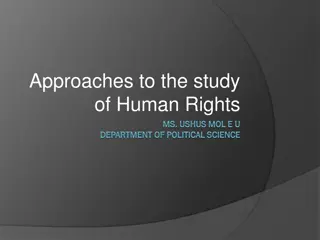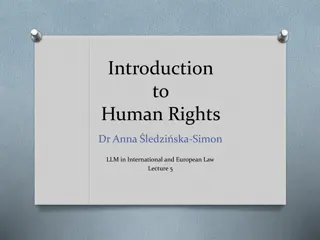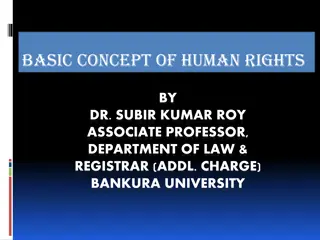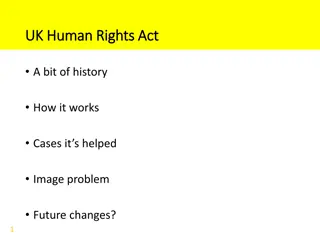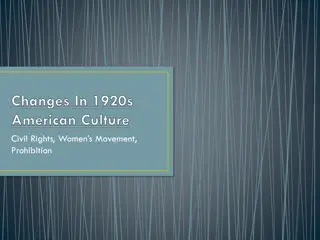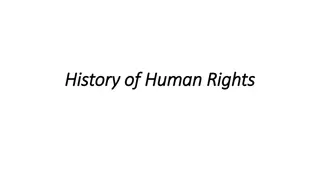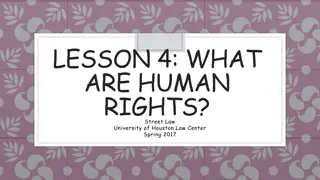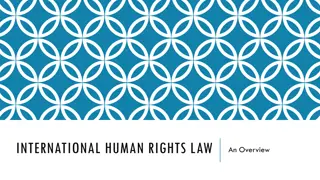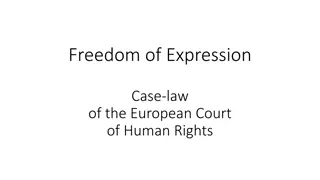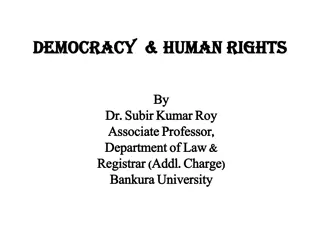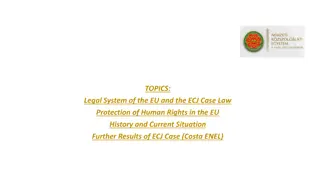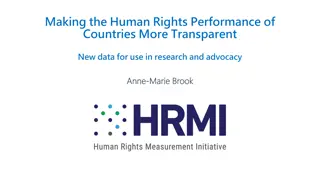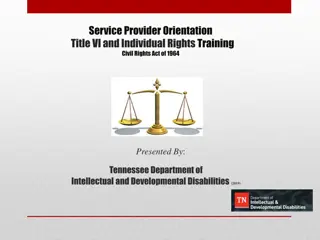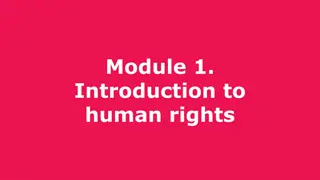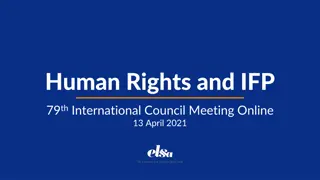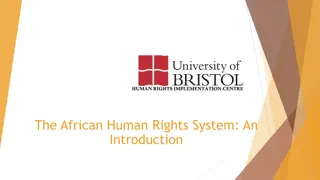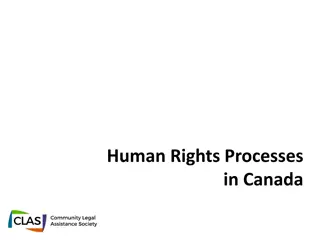Origins of Human Rights and Their Influence Throughout History
Delve into the origins of human rights, exploring their evolution from World War II to the present day. Learn about key figures like Eleanor Roosevelt, who played a crucial role in shaping the Universal Declaration of Human Rights. Discover the fundamental principles of equality, liberty, education, health, and religious freedom that underpin the concept of human rights.
Download Presentation

Please find below an Image/Link to download the presentation.
The content on the website is provided AS IS for your information and personal use only. It may not be sold, licensed, or shared on other websites without obtaining consent from the author.If you encounter any issues during the download, it is possible that the publisher has removed the file from their server.
You are allowed to download the files provided on this website for personal or commercial use, subject to the condition that they are used lawfully. All files are the property of their respective owners.
The content on the website is provided AS IS for your information and personal use only. It may not be sold, licensed, or shared on other websites without obtaining consent from the author.
E N D
Presentation Transcript
History Curriculum Over-view
Your Year 7 History Journey The Medieval World Unit 1: Unit 5: Why were the peasants revolting? Unit 3: Why did Edward the Confessor find being King so hard? What has happened before our course? What kind of change was the Norman Conquest for the people of England? Europe- Fall of the Roman Empire (476 C.E) Britain- Anglo-Saxons (from 300 C.E.) Viking Invasions (793 C.E) England forms (927 C.E) The World- Birth of Muhammed and the rise of Islam (800s C.E) Where are you going next year? Sources Causation Change & Continuity The Early Modern World, c. 1500- c.1900 C.E Henry VIII and the Reformation The British Civil Wars The British Empire Slavery through time Britain in the long 19th Century 1000 C.E. 1100 C.E. 1200 C.E 1300 C.E. 1400 C.E 1500 C.E. Unit 2: Unit 4: Why did the Normans win the Battle of Hastings? What was the medieval world really like? Interpretations Causation Unit 6: What is Derbyshire's migration story? Significance
Assessment 7.1- Why did Edward find being king so difficult? Substantive, First Order Concepts: Core Developing Advanced A basic understanding that Vikings attacked England An acknowledgment of the fact that power was contested A surface level understanding that religion was important to Edward An understanding that the Viking raids caused problems in England An understanding that there were multiple power bases in 11th C. England An understanding of how religious beliefs could affect the decisions of rulers An understanding that the Viking raids could cause problems for those trying to rule England An understanding of how weak leadership could lead to political instability. An understanding that religious belief had real world implications, especially when one is as pious as Edward. Second Order Concept: Causation Developing Core Advanced Answer describes the topic rather than the question. Paragraphs attempted, but not always successfully. Hardly any key terminology or evidence is used. Answer contains clear points that mostly focus on the question. Attempts to organise work using paragraphs. Answer uses some key terminology and a few pieces of specific evidence, however these are not enough to be called thick description. A descriptive answer that fails to explain why the evidence discussed links to the question that has been asked. Answer has clear points that are focused on the question. Attempts to write in factors, but may not always be successful. Demonstrates impressive subject knowledge. Uses thick description with key terms and a specific examples. Key terminology is used. Begins to explain how the evidence discussed links back to the question. This is likely to be fairly basic though.
Assessment 7.2 Why did the Normans win the Battle of Hastings? Substantive, First Order Concepts: Core Developing Advanced A basic understanding the 11th century was a time of instability A basic grasp of the nature of 11th century warfare An understanding of how you became monarch in the 11th century An understanding of how weak leadership could lead to political instability. A grasp of the weapons and tactics used in 11th century warfare An understanding of how succession worked in the 11th century and some problems it could cause An understanding of how instability could attract the attention of power-hungry figures like William and Harald. An understanding of what could lead to success on an 11th century battlefield An in-depth understanding of how succession issues could lead to crisis Second Order Concept: Causation Core Answer has clear points that are focused on the question. Attempts to write in factors, but may not always be successful. Uses key terms and evidence. Several key terms are used. However, there may be inaccuracies, misconceptions or some evidence missing. A descriptive answer that fails to explain why the evidence discussed links to the question that has been asked. Developing Advanced Answer contains clear points that mostly focus on the question. Attempts to organise work using paragraphs. Answer uses some key terminology and a few pieces of specific evidence, however these are not enough to be called thick description. Answers are organised into factoredparagraphs with a clear focus on the question. This leads to strong communication and literacy skills. Demonstrates impressive subject knowledge. Uses thick description with key terms and a variety of specific examples. Key terminology is used. Attempts to explain by using the wording from the question. However, these are likely to be brief and do not persuadethe reader. Why does this matter? May contain judgements, but these are likely to be basic factor X is more important than factor Y.
Assessment 7.3 What kind of change was the Norman Conquest? Substantive, First Order Concepts: Core Developing Advanced An understanding of the reasons for, events of and consequences of rebellion against Norman rule An understanding of the nature of monarchy and power in Norman England An understanding that in this period might= right was an accepted form of governmental power A recognition of changes in society A basic understanding: That rebellions to Norman rule occurred Of the king of monarchy & government the Normans introduced Of how military force can be used to enforce control Of Norman society As core, but: An in depth understanding of how the Normans changed Anglo-Saxon England into something new, including: The changing role of the monarchy and tightening of government control, including feudalism The extent to which Anglo-Saxon society survived the invasion. Concept: Change and Continuity Developing Core Advanced Answer describes the topic rather than the question. Paragraphs attempted, but not always successfully. Hardly any key terminology or evidence is used. PETS criteria either not used, or used incorrectly. May make passing reference to change or continuity Answer contains clear points that mostly focus on the question. Attempts to organise work using paragraphs. Answer uses some key terminology and a few pieces of specific evidence, however these are not enough to be called thick description. A descriptive answer. It may identify what changed but fails to explain why it changed or how far it changed. May make reference to the PETS criteria; but these references are basic and add little of value to the answer. Answer has clear points that are focused on the question. Attempts to write in factors, but may not always be successful. Demonstrates impressive subject knowledge. Uses thick description with key terms and a specific examples. Key terminology is used. The PETS criteria are used increasingly confidently and accurately throughout the answer. Begins to explain why and/or how far things changed, however these remain basic. Identifies ways in which different groups experienced this event differently
Assessment 7.4- Why cant historians agree about the Medieval period? Substantive, First Order Concepts: Core Developing Advanced Identify key features of the medieval period Describe different interpretations about the period. Identify ways historians might disagree about: Medieval society Medieval religion Medieval politics Know when in history the medieval period was Recall basic facts about medieval religion, such as its role in education or health care A basic description of social conditions- most likely to focus on filth A basic understanding of political power in this period Compare positive and negative views of: Medieval society Medieval religion Medieval politics With own knowledge, leading to a balanced description of each factor. Concept: Interpretations Developing Core Advanced Answer describes the topic rather than the question. Paragraphs attempted, but not always successfully used. Hardly any key terminology or evidence is used. May make passing reference to the interpretations but this add little of value. Very basic judgements about the validity of arguments has been made Answer contains clear points that mostly focus on the question. Attempts to organise work using paragraphs. Answer uses some key terminology and a few pieces of specific evidence, however these are not enough to be called thick description. A descriptive answer. It may describe the interpretation OR provide description of the period. Evidence is rarely used to analyse the interpretation. Judgements about the validity of interpretations have been made. These remain surface level an often unconvincing. Answer has clear points that are focused on the question. Attempts to write in factors; generally successful. Demonstrates impressive subject knowledge. Uses thick description with key terms and a specific examples. Key terminology is used. This own knowledge is increasingly used to analyse the interpretation, rather than simply to describe it. Begins to explain why and/or how evidence supports/challenges the interpretation, however these remain basic. An overall judgement on the interpretation may have been made. However, this is likely to be basic and unconvincing.
Assessment 7.5 What happened to Wat? Substantive, First Order Concepts: Core Developing Advanced A basic understanding of the causes and/or events of the Peasants Revolt. These are likely to be surface level and may refer to: - The Black Death - 100 Years War - The march on London - Wat was killed A more detailed, specific summary of events. Key information is now used and linked to the sources. Students demonstrate a clear understanding of the events surrounding the Peasants Revolt and Wat s death. They are able to link quotes to specific, detailed examples from their own knowledge Concepts: Sources Developing Core Advanced Unclear whether the student has actually understood the source. Quotes are either missing entirely or used in an inaccurate manner. They are likely to be overly long, overly short or inappropriate to the point being made. May use the levels of certainty phrases, but these are either used incorrectly or do not add value. The ability to describe events using one source Student demonstrates a competent comprehension of the source. This is often shown through use of quotes. Quotes are generally used in an accurate manner. They may still be overly long, overly short or slightly inappropriate to the point being made. Begins to use the levels of certainty phrases, but these may still be tokenistic. Sometimes feel like they re just being used for the sake of it. The ability to describe events using multiple sources The source has been fully understood. This is demonstrated through a competent use of quotes. Quotes are used in an accurate manner. They are now very rarely overly long, overly short and are appropriate to the point being made. The levels of certainty phrases are used throughout the second answer. They allow the student to not only describe events using multiple sources but to also begin to make implicit judgements about the value of different sources.
Assessment 7.6 What is Derbyshire's migration story? Substantive, First Order Concepts: Core Developing Advanced An understanding of the chronology of Britain s migration story. Who arrived when? Multiple examples are used to illustrate this. Evidence is used to describe why these groups moved and the impact they had. Several local examples are used. A basic understanding that several waves of migrants have moved to our region. Several examples, including may be used to illustrate this; for example the Vikings or Windrush Generation. A basic understanding of why these groups might have moved here and when they moved. Some comment may be made about the impact these groups have had on Britain and Derbyshire Few local examples are used. Can define key terms like migrant and migration As Core, but: An ability to inter-weave the local and national story. For example, how was Derbyshire affected by the migration of X? The ability to compare different groups, allowing students to make generalisations about migrants, their reasons for moving and their impact. Concept: Significance Developing Core Advanced Answer contains clear points that mostly focus on the question. Attempts to organise work using paragraphs. Answer uses some key terminology and a few pieces of specific evidence, however these are not enough to be called thick description. Any answer that does not explain should be awarded Developing. Answer has clear points that are focused on the question. Attempts to write in factors, but may not always be successful. Answer uses some key terminology and a few pieces of specific evidence, however these are not enough to be called thick description. May make reference to the significance criteria; but these references are basic and add little of value to the answer. The answer may attempt to make basic explanations about how significant events are. These may leave the reader asking why or how things are significant. Answers are organised into factoredparagraphs with a clear focus on change. This leads to strong communication and literacy skills. Demonstrates impressive subject knowledge. Uses thick description with key terms and a variety of specific examples. Key terminology is used. The significance criteria are used throughout the answer, these begin to add value to the answer. Explanations for why things may or may not be significant are more competent that in Core, but are still likely to be relatively brief and do not always persuade the reader. May contain judgements, but these are likely to be basic, e.g. X was significant.
Your Year 8 History Journey The Early Modern World Unit 1: What was the impact of the reformation? Unit 2: What has happened before our course? Unit 5 Why did Civil War break out in 1642? How far did Britain experience a silent revolution in the Long Nineteenth Century? Where are you going next year? Significance Change and Continuity Causation The Medieval World, c.1000- c.1500 C.E. The Norman Conquest (1066) Feudalism and Medieval life Black Death (1348) The Peasants Revolt (1381) The Modern World, c.1900- present The First World War Europe and the Dictators The Second World War Genocide in the 20th C. Post-war Britain 1500 C.E. 1600 C.E. 1700 C.E 1800 C.E. 1900 C.E Unit 3: How should we remember the British Empire? Interpretations Unit 4: How alien was the Trans-Atlantic Slave trade? Change and Continuity
Assessment 8.1: How significant is Henry VIII for Derbyshire? Substantive, First Order Concepts: Core Developing Advanced A basic understanding of key terms including: Monastery Reformation Protestant Catholic Break from Rome Puritan An understanding of the reasons why Henry broke from Rome. An understanding of the impact of these changes on Britain Some local examples are used to illustrate these changes Local examples are used to illustrate the impact of the Reformation An understanding of the short- and long- term impacts of Henry s changes The ability to use the R s of significance to analyse these changes. Concept: Significance Developing Core Advanced Any answer that does not explain cannot get higher than Developing. Answer has clear points that are focused on the question. Attempts to write in factors, but may not always be successful. Answer uses some key terminology and a few pieces of specific evidence, however these are not enough to be called thick description. Hardly any use of local examples The answer may attempt to make basic explanations about how significant events are. These may leave the reader asking why or how things changed. Answers are organised into factoredparagraphs with a clear focus on the change. This leads to strong communication and literacy skills Demonstrates impressive subject knowledge. Attempts to use thick description . There is a good range of key terms and specific examples. Key terminology is used, but there may be inaccuracies, misconceptions or some evidence missing. Some reference to local examples May make reference to the significance criteria; but these references are basic and add little of value to the answer. Attempts to explain why or how far things are significant. However, these are likely to be brief and do not persuade the reader. So what?! As Core, but: Demonstrates excellent subject knowledge. Uses thick description to provide a range of key terms and specific examples. Key terminology is used well. Local examples are used throughout the answer. A thorough, increasingly convincing explanation of the level of significance. Does not just say something is resonant but really, thoroughly explains the link between Henry and later events. Increasingly persuasivejudgements can be found in the conclusion. These will consider the extent of significance. However, links to the evidence or overall argument may still be patchy. Answers are beginning to show signs of being argumentative. Evidence is deployed to fit a line of argument on the extent of significance.
Assessment 8.2 Why did Civil War break out in 1642? Substantive, First Order Concepts: Core An understanding of how government spending cause controversy A recognition that different religious groups existed in 17th C England. Identify areas of conflict between Parliament s self- perceived role and the monarch s self-perceived role How James and Charles personalities contributed to war Second Order Concept: Causation Core Answer has clear points that are focused on the question. Attempts to write in factors, but may not always be successful Uses key terms and evidence. Several key terms are used. However, there may be inaccuracies, misconceptions or some evidence missing. Attempts to explain by using the wording from the question. However, these are likely to be brief and do not persuadethe reader. Why does this matter? May contain judgements, but these are likely to be basic factor X is more important than factor Y. Developing Advanced As core, but: Is able to demonstrate how political problems can grow in importance over time if not addressed (e.g. gov. spending) Analyse why the Divine Right of Kings was so controversial in an age of increasing assertive parliamentarianism An understanding of the importance of personality in an absolute monarchy A basic understanding of; What taxation means What Parliament is and what its role is What a civil war is How 17th century British monarch saw themselves and their place in society James and Charles personalities Developing Advanced Answer contains clear points that mostly focus on the question. Attempts to organise work using paragraphs. Answer uses some key terminology and a few pieces of specific evidence, however these are not enough to be called thick description. A descriptive answer that fails to explain why the evidence discussed would lead to war Answers are organised into factoredparagraphs with a clear focus on the question. This leads to strong communication and literacy skills Demonstrates impressive subject knowledge. Uses thick description with key terms and a variety of specific examples. Key terminology is used well. Explanations are increasingly impressive and mostly link evidence back to the question. However, on occasion the reader may be left asking why or how . Increasingly persuasivejudgements can be found in the conclusion. However, links to the evidence or overall argument may be patchy.
Assessment 8.3 How should we remember the British Empire? Substantive, First Order Concepts: Core Be able to describe different interpretations on empire. Be able to give examples of how the empire affected different parts of the world. This could include examples of violence and suppression (e.g. Indian mutiny) and possible benefits (e.g. medicine). Describe the reasons why Britain wanted an empire Developing Advanced Be able to define key terms such as: Dominion Empire Colony An awareness of when and where the empire was. Give examples of several countries within the empire. Compare factors about why the British wanted an empire, including international rivalry, financial reasons and the role of the man on the ground . Give examples of Britain s impact on her colonies to make broader statements about the role empires have played in world history. Reflect on the role of power (Who has it? How is it used) in empire Concept: Interpretations Core Answer has clear points that are focused on the question. Attempts to write in factors; generally successful. Demonstrates impressive subject knowledge. Uses thick description with key terms and a specific examples. This own knowledge is increasingly used to analyse the interpretation, rather than simply to describe it. Begins to explain why and/or how evidence supports/challenges the interpretation, however these remain basic. An overall judgement on the interpretation may have been made. However, this is likely to be basic and unconvincing. Developing Advanced Answer contains clear points that mostly focus on the question. Attempts to organise work using paragraphs. Answer uses some key terminology and a few pieces of specific evidence, however these are not enough to be called thick description. A descriptive answer. It may describe the interpretation OR provide description of the period. Evidence is rarely used to analyse the interpretation Fails to explain why the evidence discussed would support/challenge the interpretation Answers are organised into factoredparagraphs with a clear focus on the question. This leads to strong communication and literacy skills Demonstrates impressive subject knowledge. Uses thick description with key terms and a variety of specific examples. Key terminology is used to analyse the interpretation. Explanations are increasingly impressive and mostly link evidence back to the question. However, on occasion the reader may be left asking why or how this supports the argument. Increasingly persuasivejudgements on the validity of the interpretation can be found in the conclusion. However, links to the evidence or overall argument may be patchy. Basic comparisons between interpretations may be made.
Assessment 8.4 The Trans-Atlantic Slave Trade Substantive, First Order Concepts: Core Developing Advanced A basic understanding of the causes and/or events of the Peasants Revolt. These are likely to be surface level and may refer to: - The Black Death - 100 Years War - The march on London - Wat was killed A more detailed, specific summary of events. Key information is now used and linked to the sources. Students demonstrate a clear understanding of the events surrounding the Peasants Revolt and Wat s death. They are able to link quotes to specific, detailed examples from their own knowledge Concepts: Sources Developing Core Advanced Unclear whether the student has actually understood the source. Quotes are either missing entirely or used in an inaccurate manner. They are likely to be overly long, overly short or inappropriate to the point being made. The ability to describe events using at least one source References may be made to accuracy, reliability and/or value, but these demonstrate misunderstandings or add little of value to the answer Judgements about value are missing or so basic as to add little value Limited evidence of own knowledge to analyse source content/origins Student demonstrates a competent comprehension of the source. This is often shown through use of quotes. Quotes are generally used in an accurate manner. They may still be overly long, overly short or slightly inappropriate to the point being made. The ability to describe events using multiple sources Students are increasingly able to comment on accuracy, reliability and value. It is clear what criteria they are using in these judgement comments, although they may not always be fully developed and therefore remain unconvincing in places. Some evidence of own knowledge to analyse source content/origins The sources have been fully understood. This is demonstrated through a competent use of quotes. Quotes are used in an accurate manner. They are now very rarely overly long, overly short and are appropriate to the point being made. When discussing reliability students clearly select at least one of the TOP criteria- this is most likely to be origin. Not only are relevant features identified, they are now explained in an increasingly persuasive manner, leading to a judgement on the reliability of the source. When discussing accuracy, students are able to use a wide range of own knowledge to test the claims made in the source When discussing value, students show evidence of having considered the source s accuracy and reliability before coming to a judgement. At this level it may not be fully convincing yet.
Assessment 8.5 How strange was early modern slavery? Substantive, First Order Concepts: Core Developing Advanced An understanding of how the Trans-Atlantic slave trade worked. An in depth understanding of planation life, work and conditions The ability to describe slavery in at least two other time periods, giving specific examples of the nature of slavery in this period. A basic understanding: Of the Trans-Atlantic slave trade Plantation life and conditions That slavery existed in other cultures and periods. Some basic descriptions can be made of the key features of slavery in these periods. Surface level comparisons between periods are made. The ability to discuss: The ways people became slaves The work slaves did The importance and role of race in slavery The living conditions of slaver in multiple time periods, showing the ability to compare these themes across periods. Concept: Change and Continuity Core Answer has clear points that are focused on the question. Attempts to write in factors, but may not always be successful Uses key terms and evidence. Several key terms are used. However, there may be inaccuracies, misconceptions or some evidence missing. Attempts to explain why or how far things changed. However, these are likely to be brief and do not persuade the reader. Why did this lead to change? May contain judgements, but these are likely to be basic, e.g. X was a big change. Developing Advanced Any answer that does not explain cannot get higher than Developing. Answer contains clear points that mostly focus on the question. Attempts to organise work using paragraphs. Answer uses some key terminology and a few pieces of specific evidence, however these are not enough to be called thick description. A descriptive answer. It may identify what changed but fails to explain why it changed or how far it changed. Answers are organised into factoredparagraphs with a clear focus on change. This leads to strong communication and literacy skills. Demonstrates impressive subject knowledge. Uses thick description with key terms and a variety of specific examples. Key terminology is used well. Explanations are increasingly impressive and mostly focused on what changes took place and/or why they took place Judgements can be found in the conclusion. These will make reference to the Pace or Extent or Type or Speed of change. However, links to the evidence or overall argument may be patchy.
Assessment 8.6 How far did Britain experience a silent revolution in the long nineteenth century? Substantive, First Order Concepts: Developing Core A basic understanding that: Britain experienced economic changes. Examples such as Arkwright are used to support this Britain experienced social changes due to urbanisation People fought for, and eventually won their political rights during this period. The ability to define revolution . by comparing 1918 to 1789. Concept: Change and Continuity Developing Any answer that does not explain cannot get higher than Developing. Answer has clear points that are focused on the question. Attempts to write in factors, but may not always be successful. Demonstrates good subject knowledge. Attempts to use thick description . There is a range of key terms and specific examples. Key terminology is used, but there are inaccuracies, misconceptions or some evidence missing. May make reference to the PETS criteria; but these references are basic and add little of value to the answer. The answer may attempt to make basic explanations. These may leave the reader asking why or how things changed. May contain judgements, but these are likely to be basic, e.g. X was a big change. unconvincing e.g. X was a big change. Advanced An understanding of the reasons for, specific examples of and consequences of economic change An understanding of the reasons for, specific examples of and consequences of social change An understanding of the reasons for, specific examples of and consequences of political change A basic analysis of how revolutionary these changes are As core, but: Demonstrates the ability to link the 3 themes. How did the economic change influence social for e.g.? A wide variety of specific examples, such as Chartism, the experience of Coal Miners and the story of Richard Arkwright may be used. An in-depth analysis demonstrates the ability to fully compare the Britain of 1918 to that of 1789. Core Advanced Answers now use factored paragraphs that focus on an element of change or continuity. This leads to strong communication and literacy skills. An increasingly thick description is used, with a good range of key terms and evidence throughout. However, in some cases there may still be inaccuracies or some evidence missing. The PETS criteria are used with increasing confidence. They now add analytical value to the answer rather than just being there for the sake of it. Explanations are increasingly impressive and mostly focused on what changes took place and/or why they took place. There may still be areas that are not fully explained. May contain judgements, but these are likely to be As Core, but: Evidence is now placed in its historical context, showing some mastery of the material being discussed. Increasingly convincing explanations. These explain what changed and/or why it changed. The leader is no longer left asking why or how things changed. The PETS criteria is used consistently well to support these explanations. At this level pupils will also begin to discuss the inter- relation of factors (i.e. how they link) with reference to change. Judgements are increasingly persuasive and detailed. It is clear that they have analysed the evidence to come to a conclusion on the Pace, Extent, Type, Speed of change. These judgements may be found throughout the answer, as well as in the conclusion. Answers are somewhat argumentative. Evidence is used to fit a line of argument on the nature of the change. The best answers may discuss continuities as well as changes.
Your Year 9 History Journey The Modern World Unit 5: Unit 1: What has happened before our course? Unit 4: What stories should we tell about WW2? Post-war Britain: The story of Sam Beaver- King The First World War Where are you going next year? GCSE Medicine (links to Medieval Y7, Early Modern, Y8, World Wars, Y9) Elizabethan England (links to Y8 Tudors) WW1 (links to Y9) Germany, 1890-1945 (links to Dictators, Y9) Causation The Early Modern World, c. 1500- c.1900 Change and Continuity Interpretations Henry VIII and the Reformation The British Civil Wars The British Empire Slavery through time Britain in the long 19th Century 1900 1910 1920 1930 1940 1950 1960 1970 1980 1990 2000 Unit 2: How should we remember Field Marshall Haig? Unit 3: Unit 6: Genocide in the 20th Century The rise of Hitler Interpretations + Sources Causation Causation
Assessment 9.1 Why did war break out in 1914? Substantive, First Order Concepts: Core As developing but can give specific examples of for each, beginning to link those specifically to the out break of war in 1914. Developing Advanced The ability to define: Militarism Alliances Imperialism Nationalism and to make surface level links to the outbreak of war. As below, but in addition, are able to draw broader conclusions about reasons for tension between countries and about how countries can slide towards conflict. The most able may be able to link this to contemporary events and/or conflicts. Second Order Concept: Causation Core Answers are organised into factoredparagraphs with a clear focus on the question. This leads to strong communication and literacy skills Demonstrates impressive subject knowledge. Attempts to use thick description . There is a good range of key terms and specific examples. Key terminology is used, but there may be inaccuracies, misconceptions or some evidence missing. Explanations are increasingly impressive and consistently link evidence back to the question. However, on occasion the reader may be left asking why or how . May contain judgements, but these are likely to be basic factor X is more important than factor Y. May mention how factors link or inter-connect. Developing Advanced Any answer that does not explain cannot get higher than Developing. Answer has clear points that are focused on the question. Attempts to write in factors, but may not always be successful. Answer uses some key terminology and a few pieces of specific evidence, however these are not enough to be called thick description. Attempts to explain by using the wording from the question. However, these are likely to be brief and do not persuadethe reader. Why does this matter? As Core, but: Demonstrates excellent subject knowledge. Uses thick description to provide a range of key terms and specific examples. Key terminology is used well. Explanations are developed and increasingly convincing. It is clear why the evidence being discussed matters. May attempt to use the language of causation. Increasingly persuasivejudgements can be found in the conclusion. However, links to the evidence or overall argument may be patchy. Answers beginning to show signs of being argumentative and attempted to convince the reader that this version of history is correct. This is done by beginning to compare the importance of factors. May identify how factors link, but explanations of these links are not always convincing.
Assessment 9.2: How should we remember Field Marshall Haig? Substantive, First Order Concepts: Core Developing Advanced Be able to provide basic evidence to discuss Haig s legacy. This might include: - The death toll at the Somme - Conditions at Passchendaele. - He lived in a chateau These are likely to be fairly surface level. To provide a more complex view of Haig s character and achievements. As with developing, but may now provide counter-argument with facts such as: - Haig s role in developing new tactics/tech (e.g. the tank) - Haig s logistical achievements As Core, but is able to place Haig s achievements and failures in the context of war. Facts are no longer considered in isolation, e.g.: - The death toll at the Somme is now considered in light of the defender s advantage prevalent on the W. Front Concepts: Interpretations & Sources Developing Core Advanced Sources Most likely discusses accuracy or TOP. Alternatively, one is discussed in a way that does not add value to the answer. Basic own knowledge is used. Sometimes links to the content of the sources. Quotes may be used, but either incorrectly, or so that that disrupt the flow of the prose. Will discuss positives OR negatives A basic value judgment may be made. Surface level. Interpretations Discusses positives OR negatives of the interpretation Some basic own knowledge is used. However, this is rarely linked to the historian. Quotes may be used, but either incorrectly, or so that that disrupt the flow of the prose. Little attempt to explain why this makes the historian more/less persuasive A basic overall judgement. Surface level, unpersuasive. Sources Discusses TOP and accuracy Uses quotes from the source to further the argument. Comments on accuracy may be fairly surface level meaning the argument often remains unconvincing. Comments on TOP, but again surface level. E.g. it is a diary, diaries are personal, therefore good. Basic explanation of how accuracy/TOP affects value, however these may remain unconvincing. An overall judgement on value is made. This may not be fully convincing. Interpretations Discusses positive AND negatives of the interpretation Own knowledge is more developed and specific, but may not always linked to the quotes used. Attempts to explain why this makes the historian more/less persuasive, but at times still unconvincingly An overall judgement is made. This may not be fully convincing. Sources Quotes are used with increasing skill and accuracy, adding to the flow of the argument. When discussing accuracy a range of specific own knowledge is used the challenge/support the source When discussed TOP specific, detailed reference to the TOP are made. It is clear how these add/detract from value. Increasingly moves beyond the surface level. A thorough, detailed overall judgement on value is made. Interpretations As Core, but: Own knowledge is used to directly engage with the interpretation This feeds into developed explanations of why the student agrees/disagrees with the historian A thorough, detailed overall judgement on is made. The best answers may bring in alternative interpretations of Haig.
Assessment 9.3 How did Hitler come to power in the land of poets and thinkers' Substantive, First Order Concepts: Core An understanding of: The aims and beliefs of the National Socialists The way the Weimar system worked The impact of the Wall St. Crash on Germany Developing Advanced Define key terms such as: Democracy Nationalism Dictatorship Parliament (Reichstag) Anti-Semitism Tease out: What the story of Hitler can tell us about the nature of extremism in a democracy How democracies can fail The impact of economic crises on voters Why people lean towards extremism in time of crisis Second Order Concept: Causation Core Answers are organised into factoredparagraphs with a clear focus on the question. This leads to strong communication and literacy skills Demonstrates excellent subject knowledge. Uses thick description to provide a wide range of key terms and specific examples. Key terminology is used consistently well. Explanations are developed and increasingly convincing. It is clear why the evidence being discussed matters. May attempt to use the language of causation. Increasingly persuasivejudgements can be found in the conclusion. However, links to the evidence or overall argument may be patchy. Identifies how factors link, but explanations of these links are not always convincing. Developing Advanced Any answer that does not explain cannot get higher than Developing. Answer has clear points that are focused on the question. Attempts to write in factors, but may not always be successful. Demonstrates impressive subject knowledge. Attempts to use thick description . There is a good range of key terms and specific examples. Key terminology is used, but there may be inaccuracies, misconceptions or some evidence missing. The answer may attempt to make basic explanations. These may leave the reader asking why or how . May contain judgements, but these are likely to be basic factor X is more important than factor Y. As Core, but: A range of causation language is used which allows pupils to convincingly explain their ideas. Judgements are mostly persuasive and it is clear why the pupils has come to this conclusion. It is likely that these judgements are found throughout the answer, not just in the conclusion. Answers are increasingly argumentative and seek to convince the reader that their version of history is correct. This is done by comparing the importance of factors. Links between factors are no longer just identified; they are explained.
Assessment 9:4 What stories should we tell about the Second World War? Substantive, First Order Concepts: Core Developing Advanced A basic chronological understanding of Britain s war A basic description of several key events for Britain, including; D-day, Dunkirk, the Blitz. Recall the traditional interpretation of the war. As developing, but: Several episodes from Britain s war can be brought together to summarise Britain s war-time experience and importance. Students can comment on the nature of warfare in the 20th Century As core, but: Analyse Britain s role in the war, using a range of specific examples to support this analysis. Understand how war-time propaganda has affected our memory of the war Concept: Interpretations Developing Core Advanced Any answer that does not explain cannot get higher than Developing. Answer has clear points that are focused on the question. Attempts to write in factors; sometimes successful. Demonstrates goodsubject knowledge. Attempts to use thick description with key terms and a specific examples. Own knowledge is sometimes used to analyse the interpretation, rather than simply to describe it. Begins to explain why and/or how evidence supports/challenges the interpretation, however these remain basic. An overall judgement on the interpretation may have been made. However, this is likely to be basic and unconvincing. Answers are organised into factoredparagraphs with a clear focus on the question. This leads to strong communication and literacy skills Demonstrates impressive subject knowledge. Uses thick description with key terms and a variety of specific examples. Key terminology is used to analyse the interpretation. Explanations mostly link evidence back to the question. However, on occasion the reader may be left asking why or how this supports the argument. Increasingly persuasivejudgements on the validity of the interpretation can be found in the conclusion. However, links to the evidence or overall argument may be patchy. Basic comparisons between interpretations may be made. Answers are now fully organised into factored paragraphs Evidence is thick and used to analyse specific elements of the interpretation. Explanations are now mostly convincing and explain why evidence supports/challenges the interpretations. A clear, persuasive judgement on the validity of the interpretations has been made. There is little doubt as to why students came to that view. At the top end, students add nuance by analysing different elements of the interpretation separately. The best answers will made detailed, developed comparisons between interpretations where appropriate.
Assessment 9.5 How much change did Sam Beaver-King see in his lifetime? Substantive, First Order Concepts: Core An understanding of the importance of the MS Empire Windrush Examples of the struggles faced by non-white Britons- e.g. Rivers of Blood Examples of positive steps for non-white Britons- e.g. the work of the Civil Rights movement. Comparisons between the Britain of 1948 and the Britain of today. Developing Advanced The ability to describe the varying experiences of migrants to Britain. Specific examples such as the Notting Hill Riots or murder of Stephen Lawrence may be used to illustrate the challenges. The work of people like Sam Beaver-King and Paul Stephenson may be used to illustrate more positive changes. Students are able to compare the Britain of today with the Britain of 1948 and analyse the extent of change. A description of the importance of the Windrush generation and their contributions to British life. Multiple examples of the challenges they faced Multiple examples of the ways these people fought for their rights. Concept: Change and Continuity Core Answers are organised into factoredparagraphs with a clear focus on the question. This leads to strong communication and literacy skills Demonstrates good subject knowledge. Uses thick description to provide a wide range of key terms and specific examples. Key terminology is used consistently well. The PETS criteria are used accurately throughout the answer. Explanations are increasingly convincing. They are focused on what changed and why it changed. Identifies how factors link, but explanations of these links are not always convincing. Judgements are increasingly persuasive and it is clear why the pupils has come to this conclusion. They will make reference to the Pace, Extent, Type, Speed of change. However, judgements are likely to mostly be in the conclusion. Developing Advanced Any answer that does not explain cannot get higher than Developing. Answer has clear points that are focused on the question. Attempts to write in factors, but may not always be successful. Demonstrates a increasingly impressive subject knowledge. Attempts to use thick description . There is a range of key terms and specific examples. Key terminology is used, but there may be inaccuracies, misconceptions or some evidence missing. May make reference to the PETS criteria; but these references are basic and add little of value to the answer. The answer may attempt to make basic explanations. These may leave the reader asking why or how things changed. May contain judgements, but these are likely to be basic, e.g. X was a big change. As Core, but: Evidence is now placed in its historical context, showing mastery of the material being discussed. Increasingly sophisticated explanations that not only explain what changed, but why it changed. The PETS criteria is used consistently well to support these explanations. At this level pupils will also begin to explain the inter- relation of factors (i.e. how they link) and how this leads to change. Judgements are mostly persuasive and detailed. It is clear that they have analysed the evidence to come to a well thought out conclusion on the Pace, Extent, Type, Speed of change. These judgements will be found throughout the answer, as well as in the conclusion. This is done by competently comparing the importance of factors. Answers are increasingly argumentative throughout. Evidence is deployed to fit a line of argument on the nature of the change described. The best answers may demonstrate evidence that continuities as well as changes have been analysed.
Assessment 9.6 How does a genocide happen? Substantive, First Order Concepts: Core An understanding of the 6 stages that contribute to genocide, with a range of examples from multiple genocides used to illustrate these stages A recognition that the different stages interact An understanding that hatred, fear, apathy, self- interest and manipulation all play a role in genocide Developing Advanced An in depth understanding of the 6 stages of genocide with examples from a minimum of two genocides used to illustrate these stages. An ability to demonstrate how and why the different stages interact, leading to genocide An understanding that hatred, fear, apathy, self- interest and manipulation all play a role in genocide The most able may be able to make links to contemporary global events. The ability to define genocide. A surface level understanding of several steps and how they contributed to one or more genocides An ability to describe factors (such as government action or propaganda) that make genocide more likely Second Order Concept: Causation Core Answers are organised into factoredparagraphs with a clear focus on the question, and the stages . This leads to strong communication and literacy skills Demonstrates excellent subject knowledge. Uses thick description to provide a wide range of key terms and specific examples. Key terminology is used consistently well. Explanations are supported by the use of causation words. This leads to persuasive explanations that fully evaluate the significance of each factor. Judgements are mostly persuasive and it is clear why the pupils has come to this conclusion. However, judgements are likely to only be in the conclusion. Links between the stages are explained at a basic level. Likely to use multiple genocides as evidence. Developing Advanced Any answer that does not explain cannot get higher than Developing. Answer has clear points that are focused on the question. Attempts to write in factors, but may not always be successful. These are likely to be based around the stages Demonstrates impressive subject knowledge. Attempts to use thick description . There is a good range of key terms and specific examples. Key terminology is used, but there may be inaccuracies, misconceptions or some evidence missing. The answer may attempt to make basic explanations. These may leave the reader asking why or how . May contain judgements, but these are likely to be basic factor X is more important than factor Y. May identify how stages link and interact. Likely to rely on just 1 genocide for evidence As Core but: Evidence is now placed in its historical context, showing true mastery of the material being discussed. A wide range of causation language is being used which allows pupils to fully explain the significance of factors. At this level pupils will also fully explain the inter-relation of factors (i.e. how they link). Judgements are fully persuasive and detailed. It is clear that you have analysed the evidence to come to a well thought out conclusion. These judgements will be found throughout the answer, as well as in the conclusion. This is done by expertly comparing and linking the importance of the stages. Answers are argumentative throughout. Evidence is deployed to fit a line of argument that this version of history is correct. Likely to confidently use a variety of evidence from multiple genocides.


